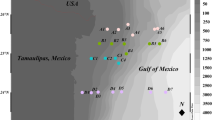Abstract
In April and September of 2005, two sediment cores were collected from Lake Aha, which is polluted by the acid mine drainage of the mining industries. Sulfate-reducing bacteria (SRB) groups and their quantity were analyzed by using PCR and FISH (fluorescence in situ hybridization), respectively. The results showed that four SRB groups (Desulfotomaculum, Desulfobulbus, Desulfococcus–Desulfonema–Desulfosarcina and Desulfovibrio–Desulfomicrobium) were detected in September, while only three SRB groups (Desulfotomaculum, Desulfobulbus and Desulfococcus–Desulfonema–Desulfosarcina) were detected in April. Desulfovibrio–Desulfomicrobium was not detected and was expected to exist inactively, in April. Meanwhile, the distribution of every SRB group was wider in September than in April. The results indicated that different SRB groups had different vertical and temporal distribution. The vertical and temporal distribution of SRB was mainly in the upper sediments, and the number of SRB groups and quantity were larger in September than in April. It suggested that the environmental conditions of sediments in September were more suitable for SRB.

Similar content being viewed by others
References
Amann RI, Ludwig W, Schleifer KH (1995) Phylogenetic identification and in situ detection of individual microbial cells without cultivation. Microbiol Rev 59:143–169
Chang BV, Shiung LC, Yuan SY (2002) Anaerobic biodegradation of polycyclic aromatic hydrocarbon in soil. Chemosphere 48:717–724
Daly K, Sharp RJ, McCarthy AJ (2000) Development of oligonucleotide probes and PCR primers for detecting phylogenetic subgroups of sulfate-reducing bacteria. Microbiology 146:1693–1705
Franzmann PD, Robertson WJ, Zappia LR, Davis GB (2002) The role of microbial populations in the containment of aromatic hydrocarbons in the subsurface. Biodegradation 13:65–78
Garcia C, Moreno DA, Ballester A, Bla′zquez ML, Gonza′lez F (2001) Bioremediation of an industrial acid mine water by metaltolerant sulfate-reducing bacteria. Miner Eng 14:997–1008
Hao OL (2000) Metal effects on sulfur cycle bacteria and metal removal by sulfate-reducing bacteria. IWA Publishing, London
Janssen GM, Temminghoff EJ (2004) In situ metal precipitation in a zinc-contaminated, aerobic sandy aquifer by means of biological sulfate reduction. Environ Sci Technol 38:4002–4011
Kleikemper J, Pelz O, Schroth MHand Zeyer J (2002) Sulfatereducing bacterial community response to carbon source amendments in contaminated aquifer microcosms. FEMS Microbiol Ecol 42:109–118
Liang XB, Zhu JM, Liu CQ (2003) Enzymatic and microbial degradation of organic matter in Lake Hongfeng of Guizhou Province. Quat Sci 23:565–572
Llobet-Brossa E, Rosselló-Mora R, Amann R (1998) Microbial community composition of Wadden Sea sediments as revealed by fluorescence in situ hybridization. Appl Environ Microbiol 64:2691–2696
Meckenstock RU, Annweiler E, Michaelis W, Richnow HH, Schink B (2000) Anaerobic naphthalene degradation by a sulfate-reducing enrichment culture. Appl Environ Microbiol 66:2743–2747
Ramsing NB, Fossing H, Ferdelman TG, Andersen F, Thamdrup B (1996) Distribution of bacterial populations in a stratified fjord (Mariager Fjord, Denmark) quantified by in situ hybridization and related to chemical gradients in the water column. Appl Environ Microbiol 62:1391–1404
Snaidr J Amann R Huber I, Ludwig W, Schleifer KH (1997) Phylogenetic analysis and in situ identification of bacteria in activated sludge. Appl Environ Microbiol 63:2884–2896
Tonolla M, Demarta A, Peduzzi S, Hahn D, Peduzzi R (2000) In situ analysis of sulfate-reducing bacteria related to desulfocapsa thiozymogenes in the chemocline of meromictic Lake Cadagno (Switzerland). Appl Environ Microbiol 66:820–824
Wan X, Wan GJ, Hang RG, Pu Y (1997a) Biogeochemical mechanism of postdepositional remobilization of Fe and Mn in Lake Aha, China. Chin Geogr Sci 7:368–374
Wan GJ, Huang RG, Pu Y (1997b) Screening effect of the diffusive boundary layer in sediments of Lake Aha in the suburbs of Guiyang City,Guizhou province. Chin J Geochem 16:347–352
Wang YC, Huang RG, Wan GJ (1998) The newly developed sample for collecting samples near the lacstrine sediment–water interface. Geol Geochem 1:94–96
White C, Sayer JA, Gadd GM (1997) Microbial solubilization and immobilization of toxic metals: key biogeochemical processes for treatment of contamination. FEMS Microbiol Rev 20:503–516
Zweifel UL, Hagström Å (1995) Total counts of marine bacteria include a large fraction of non-nucleoid-containing bacteria (ghosts). Appl Environ Microbiol 61:2180–2185
Acknowledgments
This research was jointly supported by the National Natural Science Foundation of China (Grant No. 40473050; 40173038), and NSFC/KOSEF (Grant No. 00510502).
Author information
Authors and Affiliations
Corresponding author
Additional information
An erratum to this article can be found at http://dx.doi.org/10.1007/s00254-007-1118-7
Rights and permissions
About this article
Cite this article
Wang, M.Y., Liang, X.B., Yuan, X.Y. et al. Analyses of the vertical and temporal distribution of sulfate-reducing bacteria in Lake Aha (China). Environ Geol 54, 1–6 (2008). https://doi.org/10.1007/s00254-007-0787-6
Received:
Accepted:
Published:
Issue Date:
DOI: https://doi.org/10.1007/s00254-007-0787-6



